If someone asked me, “What is one topic every student needs to work on?” the answer would be logic. Logic is needed for all reasoning skills, from critical thinking to educated guessing. You may be wondering how to help your child build these skills, but don’t worry! There are many logic puzzles for kids that are made to develop logical reasoning, critical thinking and analysis, and creative problem-solving. At A Grade Ahead, we even incorporate logic puzzles or games into our end-of-month Hands-on Activities in our curriculum! To help you practice more at home (and maybe even satisfy your technologically-loving kids), we’ve compiled this list of games and logic puzzles for kids that are available online for free. Keep reading below for the full, updated list!
25 Logic Puzzles for Kids to Build Reasoning Skills
(Updated for 2021)
Math Logic Puzzles for Kids
1. KenKen (NEW!)

The goal of a KenKen puzzle is to fill in squares with numbers without repeating a number in any row or column (Sound familiar? Cough… Suduko… Cough). KenKen puzzles sometimes include multiplication and division, so you do need a bit of math knowledge to complete these puzzles! There are some groups of these smaller squares that are separated by bold edges, called cages. If a square only has one number, fill in the square with that number. This will be the target number of the cage! If there is a mathematical operation with the target number, that means that operation must be used to get the target number.
For example, if your target number is 36, there is a multiplication sign, and there are three squares in that cage, then the numbers needed will be 4, 3, and 3 (because 4 x 3 x 3 = 36!). The placement of the three numbers would be determined by which numbers can be used in each row and column according to the rules.
Puzzles to solve can be found here on the KenKen’s official website (plus, if you need a little help with the rules, the site also provides this great resource!). You can play them online here on the Smithsonian Mag website, too!
2. Kakuro (NEW!)
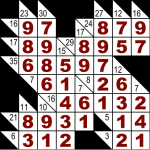
If you like crossword puzzles and math, Kakuro is your dream logic puzzle! The puzzle has sharp edges and is actually the second most popular logic puzzle in Japan. There are numbers given in triangular shapes which are called “clues.” The goal of the puzzle is to place the digits 1-9 into the while squares to make a sum that equals that “clue.” No numbers will be repeated in an entry line. This is one of the logic puzzles for kids that does require students to be comfortable with adding, subtracting, and basic algebraic thinking skills.
You can try them out at any of these great places: Karuros.com, Kakuro Conquest, or Kakuro.com!
3. Minesweeper (NEW!)
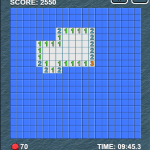
Minesweeper is a classic puzzle game, and it definitely deserves a place on this list of logic puzzles for kids. The puzzle begins with a blank grid. Some of these cells contain a “mine” that must be avoided. To begin the game, simply click a spot as normal. This will reveal either a mine (which means the game is lost!), a blank space, or a number. If a blank space is revealed, it will also reveal the other surrounding blank spaces. The squares with a digit inside show how many mines are adjacent (connected) to that square. To mark the cells that are mines, right-click the cell to place a flag there. To solve the puzzle and win the game, the solver must avoid clicking any mines by using the numbers as clues.
Play a kid-friendly themed minesweeper puzzle on Google!
4. Make Me Ten (NEW!)
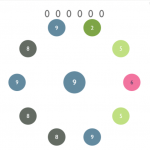
Make Me Ten is addictive, fun, and visually pleasing. It definitely feels like a game, but it actually will engage students in multi-step thought processes. The goal of the game is to combine numbers whose sum is 10. A number appears in the circle, and the player must click another number for it to go next to. Ideally, these numbers will add up to 10 and will combine to show the number 10 instead of two separate numbers. Otherwise, the player must think ahead and place it next to a number that it might be able to use. In the example from Word Games, the number to move is a 9, but there is no 1, so it would be placed somewhere in the circle. However, be strategic about placement, because the game is lost when the circle becomes too full.
If you succeed and all the numbers in the circle are ten, your goal will increase to 11, then 12, and so on.
5. Sudoku
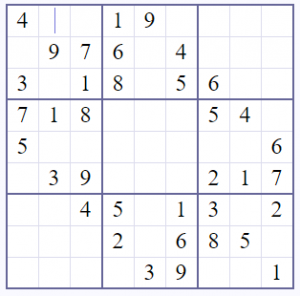 Sudoku is probably the first math puzzle you thought of when you read “logic puzzles.” It’s become wildly popular, and you can find buy books of it as well as free puzzles online. Just one problem: although it’s often called a math logic puzzle, the numbers could easily be letters or symbols – it’s all about process of elimination, not math process or numerical values.
Sudoku is probably the first math puzzle you thought of when you read “logic puzzles.” It’s become wildly popular, and you can find buy books of it as well as free puzzles online. Just one problem: although it’s often called a math logic puzzle, the numbers could easily be letters or symbols – it’s all about process of elimination, not math process or numerical values.
But don’t worry! It still helps build logic skills!
6. Strimko
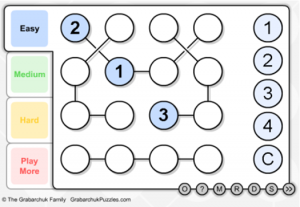 For those who like Sudoku, Strimko offers variation on the same idea. Instead of a grid, the options are laid out in chains. Each chain, column, and row can still have only 1 of each letter, but the chains can interweave, giving the idea a nicely challenging twist.
For those who like Sudoku, Strimko offers variation on the same idea. Instead of a grid, the options are laid out in chains. Each chain, column, and row can still have only 1 of each letter, but the chains can interweave, giving the idea a nicely challenging twist.
The directions provided for it are not as good as I would like, but it is nice to have the choice of difficulty level. Kids can also check the solution to clarify how to play (but if they follow my directions above, they should be fine).
7. Hashi
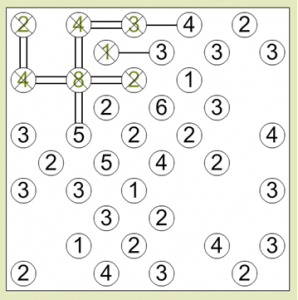 In Hashi, players have to build bridges to connect all the numbers together (no number should be isolated). Kids can build single bridges or double bridges, and the bridges can only go vertically or horizontally. They can’t go diagonally or cross each other. The real challenge, however, starts with the numbers. You see, this time, the numbers matter.
In Hashi, players have to build bridges to connect all the numbers together (no number should be isolated). Kids can build single bridges or double bridges, and the bridges can only go vertically or horizontally. They can’t go diagonally or cross each other. The real challenge, however, starts with the numbers. You see, this time, the numbers matter.
Each number indicates how many connections that circle has to have. Once a number has its max connections, an x will appear through it. All the numbers need to be crossed out in order to win, which requires strategy. Prepare to think with this one!
But don’t worry – this website provides varying levels of difficulty, so players can warm up before tackling the hard ones.
8. Nurikabe
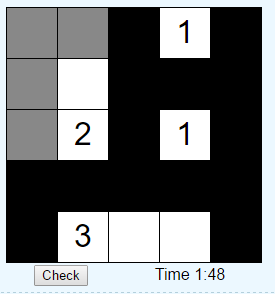 Nurikabe also has numbers that matter. In this case, the numbers indicate how many white squares connect to make an “island.” At the same time, the islands must not connect to each other, and the black squares can never make a 2-by-2 shape.
Nurikabe also has numbers that matter. In this case, the numbers indicate how many white squares connect to make an “island.” At the same time, the islands must not connect to each other, and the black squares can never make a 2-by-2 shape.
This is another good planning and strategy game, and like Sudoku, expanding the size expands the difficulty level.
9. Trees & Tents
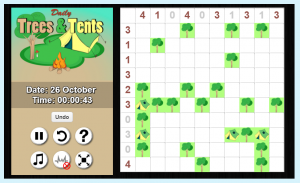 Although definitely more visual than most of the logic puzzles talked about so far, Trees & Tents does rely heavily on numbers. First off, each tree has to have 1 tent by it. Second, each row and column indicates how many tents are in it. Finding the right layout requires strategic thinking and paying close attention to the numbers on the columns and rows.
Although definitely more visual than most of the logic puzzles talked about so far, Trees & Tents does rely heavily on numbers. First off, each tree has to have 1 tent by it. Second, each row and column indicates how many tents are in it. Finding the right layout requires strategic thinking and paying close attention to the numbers on the columns and rows.
This one lets kids choose the difficulty level and the size of the grid, so they can make it as hard or easy as they like.
10. Secret Number
In Secret Number, players get a list of clues – all the clues they need to guess the missing number. The clues contain mathematical terms like “product” and “sum,” which provides good practice for word problems, and using the clues requires the process of elimination, which is one of the main logic skills that students need. Students could even make it competitive by taking turns guessing.
11. TenPair
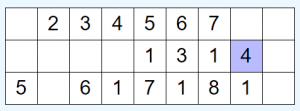 If you’ve ever played Mahjong, Bejeweled, or any other match-and-eliminate game, then you know that success (and high scores) requires strategy and a keen eye. TenPair combines that strategy requirement with arithmetic.
If you’ve ever played Mahjong, Bejeweled, or any other match-and-eliminate game, then you know that success (and high scores) requires strategy and a keen eye. TenPair combines that strategy requirement with arithmetic.
Instead of matching jewels or images on tiles, in this game, players match pairs of numbers that add to make 10 (like 2 and 8) or duplicate numbers (like 1 and 1). Pairs can only be eliminated when there are no other numbers between them vertically or horizontally (no diagonals). Also, the farthest right number of any row is considered next to the farthest left number of any row (in the example, the highlighted 4 could eliminate with the 6 on the bottom row – if the 5 weren’t there…).
Each game begins with a 3-by-9 grid as shown above, but it doesn’t stay that way for long. Once a player runs out of moves on this board and clicks “deal,” more rows appear below it. Eliminating all the numbers is a serious challenge that could keep kids occupied (and learning) for hours.
Word Logic Puzzles for Kids
12. Rebus Puzzles (NEW!)
FUNNY FUNNY
WORDS WORDS WORDS WORDS
“Too Funny For Words”
Rebus Puzzles are a sort of puzzle that uses images, symbols, individual letters, words, and phrases to represent some sort other word or phrase. For example, as part of a rebus puzzle, the word “been” might be shown as an image of a “bee” plus a letter “n.” To solve these puzzles, students must interpret clues that may represent multiple things. It also requires students to bring in their previous knowledge because many of the solutions are idioms or common sayings. The puzzles may use homophones (words that sound the same but are spelled differently and have different meanings), like the example above. For a list of rebus puzzles, check out this link. Better yet, encourage students to play it in an interactive setting, found here.
13. The Classic Brainteaser (NEW!)
What goes up and down stairs without moving?
A carpet!
This list of logic puzzles for kids would be incomplete without the classic brainteaser, which are often called riddles! Who doesn’t love solving a riddle? These logic word problems usually involve “thinking outside of the box” in some way. This type of thinking develops logic and reasoning skills because it is so different from conventional solving methods. You can find them here, and you can sort by difficulty, length, and even type!
14. The Self-Referential Quiz (NEW!)
This type of logic game asks questions about itself. For instance, the first question may ask, “What is the answer to number 2?” and the second question may ask, “How many answers in this quiz are the letter B?” and so on… These quizzes are able to be solved by close reading and using logic. Students must determine which quiz question can be answered first and figure out the relationships to all the questions and answers. You can find these at Brainzilla in various levels of difficulties. Or, try the original one created by Professor Jim Propp, who created The Self-Referential Aptitude Test as a prank or joke because only 1 of the 20 questions could be solved directly.
Practice close reading and critical thinking with an enrichment program!
15. Logic Grid Puzzles
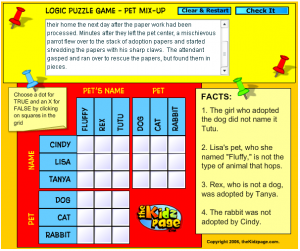 Logic Grid Puzzles have been my personal favorite logic puzzle since childhood (which might be why I’ve given you 3 different links of resources).
Logic Grid Puzzles have been my personal favorite logic puzzle since childhood (which might be why I’ve given you 3 different links of resources).
Each Logic Grid Puzzle provides a story that is solved through filling out the chart and using the process of elimination. They’re basically word problems solved with logic (no math). That means that even while students are developing logic skills, they are also practicing skills needed for word problems and reading comprehension.
(NEW!) You can also try these puzzles out at a place called Puzzle Baron! Just set the grid size and difficulty measure. The clues and backstory are on the right side and easy to access.
16. Reverse Word Searches
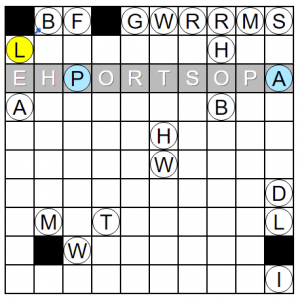 Like the name implies, this logic puzzle is a traditional word search reversed: instead of finding words and crossing them out or circling them, the goal is to find where the words fit and fill them in. You might even consider it a mix between a crossword puzzle and a word search only instead of clues, there’s a word bank. Also, words can still go forwards, backwards, diagonally, or vertically. That makes it good brain exercise and can help students practice spelling, too.
Like the name implies, this logic puzzle is a traditional word search reversed: instead of finding words and crossing them out or circling them, the goal is to find where the words fit and fill them in. You might even consider it a mix between a crossword puzzle and a word search only instead of clues, there’s a word bank. Also, words can still go forwards, backwards, diagonally, or vertically. That makes it good brain exercise and can help students practice spelling, too.
17. Cryptograms
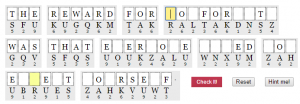 Cryptograms are encrypted messages that are decrypted through process of elimination and knowledge of the English language. For example, there are only so many 3-letter words that end with the same two letters (bee, see, too, all, etc.). That lets you narrow down the doubled letter, and looking at how that letter is used in other words in the message can help you make an educated guess. A large vocabulary, knowledge of prefixes and suffixes, and an understanding of common letter combos go a long way to improving strategies.
Cryptograms are encrypted messages that are decrypted through process of elimination and knowledge of the English language. For example, there are only so many 3-letter words that end with the same two letters (bee, see, too, all, etc.). That lets you narrow down the doubled letter, and looking at how that letter is used in other words in the message can help you make an educated guess. A large vocabulary, knowledge of prefixes and suffixes, and an understanding of common letter combos go a long way to improving strategies.
(NEW!) Try an image-based cryptogram style game called Code Breaking!
18. Word Twist
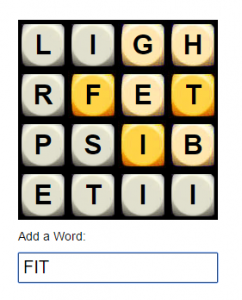 Similar to Boggle but with slightly different rules, Word Twist challenges players to find the most words from the given letters in the least amount of time. Different scores are given by the length of the words and how commonly each word is found. It’s a good game to practice visualizing words and honing spelling. Speed is a factor, and the competition is fierce!
Similar to Boggle but with slightly different rules, Word Twist challenges players to find the most words from the given letters in the least amount of time. Different scores are given by the length of the words and how commonly each word is found. It’s a good game to practice visualizing words and honing spelling. Speed is a factor, and the competition is fierce!
Check out real A Grade Ahead success stories!
Visual Logic Puzzles for Kids
19. Thanksgiving Dinner (NEW!)
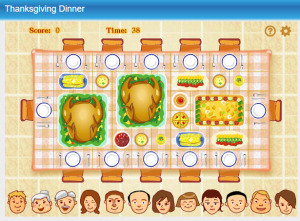
The object of this game is to place family members at Thanksgiving dinner around the table. The challenge comes from needing to place each person close to a favorite food and farthest away from the food he or she hates. Students can scroll the mouse over each family member and see that person’s likes and dislikes! This logic games makes students analyze the optimal seat placement of each person, so they must practice reasoning and ordering skills. The lighthearted theme makes it fun for students to practice higher-level thinking!
20. Nonograms (NEW!)
Nonograms, sometimes called picross or griddlers, are logic puzzles that involve coloring a cell in a grid or leaving that cell uncolored based on the numbers on the side of the grid. The purpose of solving this puzzle is to reveal a hidden picture!
The numbers on the side and top tell you how many boxes are colored in a row or column. So if a row says “2 4 1,” that would mean the row has 2 colored adjacent boxes, then one of more boxes uncolored, then 4 adjacent colored boxes, then one or more boxes uncolored, then 1 box colored. The problem is that players are not sure of the location of the colored boxes… There could be one space between the sets of colored boxes, or there could be 7! That is where the column labels would come in.
Students must use the clues given in both the rows and columns to come up with a solution that reveals a picture. While solving nonograms, students will practice serious logical thinking, and even have a picture to show for their efforts! You can try solving nonograms here or here.
21. Entangled (NEW!)
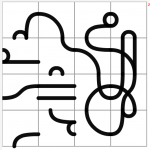
The goal of Entangled is to make seemingly random lines into a closed, connected shape. This game gets kids practicing spacial awareness and problem solving skills. Students practice logic and reasoning while figuring out how many times to rotate each grid. The version above is from Word Games and it is super user-friendly. Students simply click each square to rotate it by 90 degrees, a ¼ way turn! Then, the puzzle is marked as solved when the closed shape is created. Each level gets more difficult by increasing the number of squares.
22. Magnets
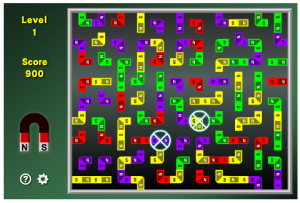 Like TenPair, Magnets is another match-and-eliminate puzzle. In this one, the goal is to get 3 of the same color together so that they’ll disappear. There’s 1 big complication: the colored pieces are magnets. That means that they are polarized – they can only join together at certain points. So if you can’t turn them so that N and S are together, they won’t disappear.
Like TenPair, Magnets is another match-and-eliminate puzzle. In this one, the goal is to get 3 of the same color together so that they’ll disappear. There’s 1 big complication: the colored pieces are magnets. That means that they are polarized – they can only join together at certain points. So if you can’t turn them so that N and S are together, they won’t disappear.
Combined with the shapes of the magnets, this lends a level of difficulty beyond regular match-and-eliminate games, requiring additional strategies and applying natural sciences, as well.
23. Lights Out
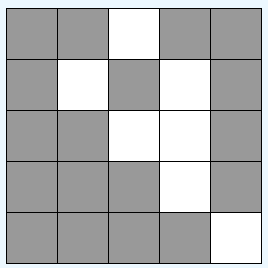 Lights Out reminds me of rubik’s cubes – once the child gets the trick, it’s all about seeing how fast he or she can do it. Until then, however, the challenge of figuring it out can definitely take some thinking. Not bad for a game where all you have to do is click on squares!
Lights Out reminds me of rubik’s cubes – once the child gets the trick, it’s all about seeing how fast he or she can do it. Until then, however, the challenge of figuring it out can definitely take some thinking. Not bad for a game where all you have to do is click on squares!
24. Netwalk
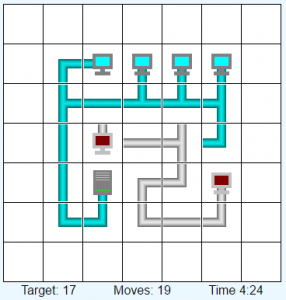 Who knew there were games about network administration? In Netwalk, the goal is to rotate the tiles to connect the server to each computer and leave no loose ends. (And I’m assuming the admin is paid hourly because the secondary goal is to do it in as few steps as possible!) It’s a good way to practice problem solving and strategy. It has three levels: Beginner, Medium, and Expert.
Who knew there were games about network administration? In Netwalk, the goal is to rotate the tiles to connect the server to each computer and leave no loose ends. (And I’m assuming the admin is paid hourly because the secondary goal is to do it in as few steps as possible!) It’s a good way to practice problem solving and strategy. It has three levels: Beginner, Medium, and Expert.
This is one logic puzzle for kids that could be appropriate for younger ages, too! It’s similar to Entangled (#21), but the straight lines and level choices are more accessible to all ages.
Practice more at an A Grade Ahead academy near me!
25. GridWorks
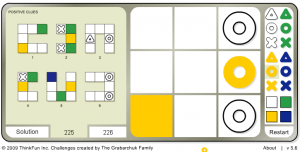 By and far my favorite of these visual logic puzzles (despite its less-than-stellar instructions), GridWorks combines colors and shapes in a challenging process-of-elimination game. The 3-by-3 game board is supposed to be filled with each of the colored shapes (x, o, and triangle in yellow, blue, and green). To find out where each of the 9 tokens goes, you have to combine a series of clues. These are much like the logic grid puzzles only now the clues are all visual rather than in words.
By and far my favorite of these visual logic puzzles (despite its less-than-stellar instructions), GridWorks combines colors and shapes in a challenging process-of-elimination game. The 3-by-3 game board is supposed to be filled with each of the colored shapes (x, o, and triangle in yellow, blue, and green). To find out where each of the 9 tokens goes, you have to combine a series of clues. These are much like the logic grid puzzles only now the clues are all visual rather than in words.
A colored square indicates only what color the shape in that space should be. A white shape indicates only what kind of shape should go in that space. The corresponding tools (colored squares and white shapes) can be used to track those clues, or you can track it in your head and place a colored shape directly. More complex clues can involve what isn’t in that space or even geometric transformations (like rotations and reflections). Students who excel at this will have a big advantage at critical thinking and problem solving!
What About My Younger Kids?
Younger kids may not be ready for some of the more advanced logic puzzles, but have no fear: there are still many options to get young children working on their logical reasoning skills! Try these from the list above, and be sure to start them out on Very Easy, Easy, or Beginner levels when available. (Plus, we don’t want students to get the too hard mentality!)
Nurikabe (#4)
Logic Grid Puzzles (#12)
Lights Out (#20)
Netwalk (#21)
Prepare your Pre-K student for school with an enrichment program!
Well, that’s the end of this exhaustive, updated list! With 25 different logic puzzles for kids to choose from, students can mix and match puzzle games so that they can keep learning without getting bored. If your child still needs a little extra help with logic and reasoning, you can always consider an enrichment program.
Did we miss any? What logic-based puzzles or games do your kids like? We would love to hear any awesome logic puzzles for kids that have worked well for your family! Be sure to comment below to share with us.
Author: Elizabeth F., Writer and Teacher at A Grade Ahead
Updated by: Brenna W., Writer and Blog Coordinator at A Grade Ahead

I believe you’re going to love the zebra puzzles as well, I’ve spent countless hours on these! https://www.brainzilla.com/logic/zebra/
i love the game of the 25-free-online-logic-puzzles-kids… thanks for sharing.